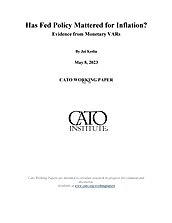Politicians are also quick to blame the Federal Reserve or assert its power over the economy. Leaders on both sides of the political aisle do the same. As inflation began to grow last year, President Biden highlighted the Fed as the key institution to combat inflation, saying “the critical job of making sure that the elevated prices don’t become entrenched rests with the Federal Reserve” (Irwin, 2022). Similarly, U.S. Senator Thom Tillis (R‑NC), a member of the Senate Banking, Housing, and Urban Affairs Committee, in comments to Fed Chair Jerome Powell said, “[r]egarding the Fed specifically – though I am pleased you have begun taking the drastic action necessary to right the U.S. economy – these actions are long-overdue” (Tillis, 2022), indicating his belief in the Fed’s control over inflationary pressure.
The empirical evidence does not support these assertions. This paper investigates the effects of unanticipated changes to monetary policy on inflation and finds that the public perception of the Fed’s ability to manage inflation is overstated. Using standard monetary Vector Auto Regressions (VARs) that are fitted to various data samples from modern U.S. economic history, we show that as a result of a one standard deviation (positive) shock to the Fed’s policy rate, inflation initially increases and only reduces after a few quarters. Not only does inflation initially move in the opposite direction the Fed would want, but the future reduction is small, with the most impact in the services sector. The goods market is the most responsive to the policy rate shock, but the effects are not as intended; in response to the policy rate change, goods prices elevate in the short term and return to normal but never reduce. In short, the desired effect (a reduction in inflation after raising the policy rate) is very small and occurs only in the services sector, but the undesired effect (an increase in inflation) happens to a greater degree on the goods market.

